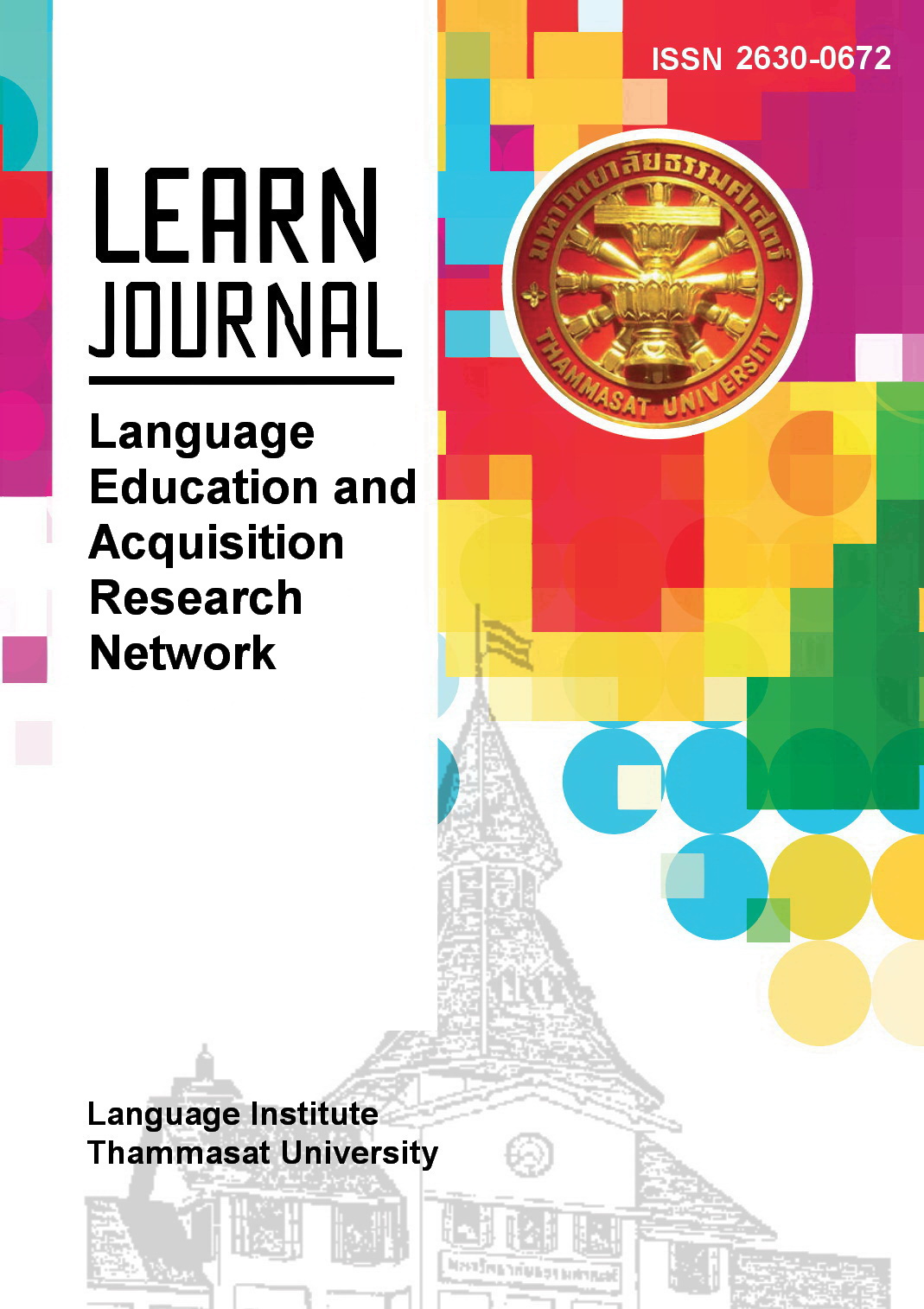Effectiveness of Learning English Words of Sanskrit Origin as Loanwords in Thai through WordWall Gamification
Main Article Content
Abstract
The objectives of this research article were to study the relations of Sanskrit to English, to investigate English words identified as of Sanskrit origin which are loanwords in the Thai language and to explore the effects of using WordWall gamification for English words of Sanskrit origin in Thai learning. The samples consisted of seven master’s degree students who were studying the Thai language in course number 01361513 Foreign Languages in Relation to the Thai language at Kasetsart University in academic year 2022. Quantitative data analysis was used in this research. The findings revealed that Sanskrit and English have a very close relation to each other because they come from the same Indo-European language family. The root-words were considered to simplify the relations of Sanskrit and English. Using WordWall gamification for English words of Sanskrit origin in Thai learning is a good adjunct tool for the implementation of improvement of word identification skills. Pre-test, post-test and intervention data indicated development of the students’ ability to deal with English words of Sanskrit origin in Thai learning and an increase in the students' identification skills. This WordWall gamification should be introduced to Thai classrooms because it helped to effect good learning of English words of Sanskrit origin that are loanwords in the Thai language and the excellent effects of using the WordWall gamification were undoubtedly found in the post-test.
Article Details
References
Anderson, L. W. & Krathwohl, D. R., et al. (2001). A taxonomy for learning, teaching, and assessing: A revision of Bloom's taxonomy of educational objectives. Longman.
Bloom, B.S. (1956). Taxonomy of educational objectives, handbook: The cognitive domain. David McKay.
Boonlue, S. (2018). Gamification in education. http://qa.hcu.ac.th/km/fileuploads/Gamification-2561.pdf.
Brown, H. D. (1994). Principles of language learning and teaching. Prentice Hall.
Cronsberry, J. (2004). Word walls: A support for literacy in secondary school classroom. http://curriculum.org/storage/258/1334340769/world_walls_a_support_for_literacy_in_secondary_school_classrooms.
Cuesta. (2020). Using digital games for enhancing EFL grammar and vocabulary in higher education. International Journal of Emerging Technologies in Learning, 15(20), 116-129.
Cunningham, P. & Allington, R. (1999). Classrooms that work. Longman.
Farisa, L., Syamaun, A. & Erdiana, N. (2018). Using word walls to improve students’ English vocabulary. Research in English and Education (READ), 3(4), 259-266.
Fox Wilker, J. & Funk, V. (2008). Using word wall activities in early childhood classrooms. Northwest Journal of Teacher Education, 6(1), 1-7.
Harmer, J. (2007). The practice of English language teaching. Longman.
Harper Collins. (2019). Collins English dictionary. https://www.collinsdictionary.com/ dictionary/english.
Hashim, H. (2019). Improving ESL learners’ grammar with gamified-learning. Arab World English Journal, 5(Special issue), 41-50.
Hasram, S., Nasir, M., Mohamad. M., Daus, Y., Rahman, M., & Mohammad, W. (2021). The effects of Wordwall Online Games (WOW) on English language vocabulary learning among year 5 pupils. Theory and Practice in Language Studies, 11(9), 1059-1066.
Harwika, (2018). Using Wordwall media to improve the students’ vocabulary mastery at the seventh grade of SMPN 4 Marioriawa Kab, Soppeng [Master’s thesis], Tarbiyah Faculty State Islamic Institute.
Chandaburinarunath, K. (1969). Pali-Thai-English-Sanskrit dictionary. Mahamakuta Rajavidyalaya.
Jantke, K. P. & Hume, T. (2015). Effective learning through meaning construction in digital role playing games. A conference paper in international conference on consumer electronics (ICCE). (pp. 686-689).
Jasmine, J., & Schiesl, P. (2009). The effects of word walls and word wall activities on the reading fluency of first grade students. Reading horizons: A Journal of Literacy and Language Arts, 49(4), 301-314.
Jorge F. F., (2015). Using gamification to enhance second language learning. Digital Education Review, 27(21), 32-54.
Lewis. (2017). The digital teacher. http://www.Wtt.Org.Uk/Index. Html.
Monier Williams. (1999). A dictionary of English and Sanskrit. Motilal Banarasidass.
National Council of Educational Research and Training. (2018). Social science: Textbook in history for class VIII. Division of Secretary, National Council of Educational Research and Training.
Phanuphong, V. (1971). Karn suksa prawat khwam penma khong pasa tam naew pasa sart cherng prawat [A study of history of language according to Historical Linguistics]. In Puey Ungphakorn (ed.), Pasasart wan waithayakorn chumnum bot khwam thang wichakarn thawai phrachao worawongther kromamun Naradhip Bongsprabandh in 80th birthday anniversary on 25 August 2514 (pp. 111-112). Thai Watana Panich.
Pimpuang, K. (2016). Fundamental sentence structure of Pali and English: A comparison for translating into Thai language. Journal of International Studies, 6(2), 46-66.
Pimpuang, K. (2019). PL-SKT word formatting in Thai politics: New approaches to compound Thai words. Journal of International Studies, 9(1), 237-262.
Pimpuang, K., Yuttapongtada, M. & Sunghor, N. (2023). Thai conversation learning and teaching for foreigners based on Thai culture context in the CTLF program at Kasetsart University: Evolution and inno-creative approach. [Unpublished article] Theory and Practice in Language Studies, 13(10).
Pongpaiboon, S. (1974). Pali-Sanskrit in relation to the Thai language. Thai Watana Panich.
Prathyusha, N. (2020). Role of gamification in language learning. International Journal of Research and Analytical Reviews, 7(2), 576-583.
Raksamani, K. (2006). Sansakrit wicharana. Mae Kam Pang.
Royal Institute, (2003). Royal institute dictionary B.E 2542. Nanmeebooks.
Srimannarayana, M.M., (2016). An introduction to Sanskrit linguistics:
Comparative and historical. B.R. Publishing Corporation.
Thongprasert, C. (1977). Karn nam kam balee leah sanskrit ma chai nai pasa Thai [Application of Pali and Sanskrit in the Thai Language]. Royal Institute, 3(2), 37-40.
Vygotsky, L. S. (1978). Mind in society: The development of higher psychological processes. Harvard University Press.
Wagstaff, J.M. (1999). Teaching reading and writing with wordwalls. Scholastic.
Werbach, K. & Hunter, D. (2012). For the win: How game thinking can revolutionize your business. Wharton Digital Press.
Wilson, L. (2016). Anderson and Krathwohl Bloom’s taxonomy revised understanding the new version of Bloom’s taxonomy. https://quincycollege.edu/wp-content/uploads/Anderson-and- Krathwohl_revised-Blooms-taxonomy.
Witayasakpan, S. (2005). Teaching Thai as a foreign language. Vannavidas, 5, (1), 215-261.


